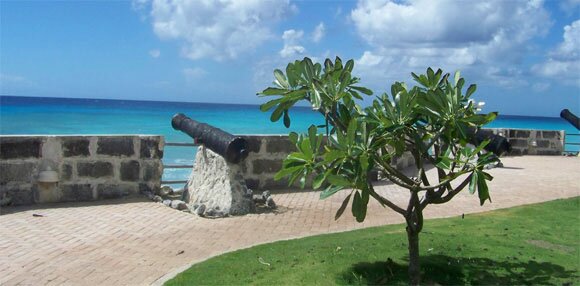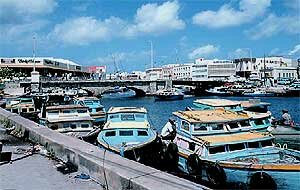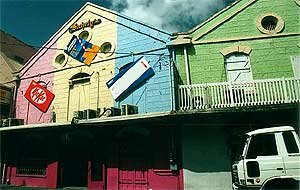|
 Photos on Barbados...click here Photos on Barbados...click here
     


SYLLABUS:
Course Outline
This English as a foreign language (EFL) course focuses on the four main language skills of speaking, listening, reading and writing, combined with aspects of local culture. This course is recommended for those who wish an intensive program, while working in small groups of 8 or less students. Classes are 55 minutes long.
Aims
The program prepares students to become effective, confident speakers of English in academic institutions and professional settings as well as in everyday life. Students are tested at the beginning of the course, counseled, and placed in the level most appropriate to their needs.
Beginners group : Level A
Intermediate group : Level B
Advanced group : Level C
The program entails intensive instruction focusing on English grammar and reading, essay writing, communication, situations and listening skills.
ASSESSMENT OBJECTIVES
The examination will test students’ ability:
(i) To show an understanding of the spoken language dealing with a range of familiar topics, and identify and note main points and specific details, including opinions.
(ii) To take part in short conversations, giving and obtaining information and opinions.
(iii) To show an understanding of a number of printed items, ranging from short, simple phrases to longer, more complex texts and identify and note main points and specific details, including opinions.
(iv) To produce pieces of writing, ranging from short phrases to longer passages in which they seek and convey information and opinions.
SYLLABUS CONTENT
INTRODUCTION
(i) The examination is based on the sixteen topics set out below.
(ii) The grammar section lists all the material which students should cover.
TOPICS
Language of the classroom
Life and work
House, home, daily routine and chores
Times, dates, numbers and prices
Personal description
Family, friends and pets
Meeting people
Sports and leisure
Countries and Travel
Visiting a café or restaurant
Simple health problems
Description of a town or region
Finding the way and using transport
Understanding tourist information
Shopping ( e.g. for food, clothes, presents)
Weather and the environment
Please note; For the Intermediate and advanced groups especially, some above-mentioned topics will be replaced with more controversial and debatable topics, such as:
Science and technology
The changing face of the family
Drug and alcohol abuse
Crime and punishment
Studies and career options
Medical advancements
ENGLISH GRAMMAR
Regular verbs and modal verbs.
Tenses including Present tense: regular and common irregular, Past, Conditional, Future, etc.
Basic Imperative forms
Interrogative forms
Singular and plural nouns and pronouns
Various numerical expressions including cardinal numbers, fractions, decimals etc
Comparative structures
Prepositions and conjunctions
SCHEME OF ASSESSMENT
LISTENING EXAM (25%) This will be based on material in the target language being delivered to students via authentic English recordings. Instructions will be given in English. There will be questions to answer on the recordings heard.
SPEAKING (25%) The examination will consist of three elements: a role-play situation, presentation of a prepared topic and a general discussion and conversation to follow.
Role-play situation
The examiner will give each candidate, at random, one situation from the three which are set, ensuring that all the situations are used to an equal extent. The situation must be acted out with the examiner acting as the other party in the situation. Credit will be given for relevant communication, appropriate response to the questions and quality of language, including pronunciation.
Presentation of prepared topic and subsequent discussion
The candidate will choose any topic covered by the syllabus or a topic in connection with a country where the target language is spoken, e.g:
a town or region a regional or national celebration an artist (painter, sculptor, writer, composer etc.) an historical figure a sportsman / sportswoman
The candidate will present his/her topic, after which the teacher/examiner will ask him/her about three questions based on it. Credit will be given for communication of information, pronunciation and intonation, range of vocabulary, range of grammar as set out in the syllabus, accuracy, fluency and readiness of response.
General Conversation
The candidate will be asked questions on the various topics covered in class, including:
house, home, daily routine and chores free-time and holiday activities life and work at school personal description, family, friends and pets
Credit will be given for relevant communication, appropriate response to the questions and quality of language, including pronunciation.
READING AND WRITING (50%)
Section A: Reading (25%)
Instructions will be given in English. There will be questions on a number of short passages. There will be several exercises of differing length, covering a range of different approaches to the development of reading skills, e.g. gap-filling, multiple choice, matching headlines to texts, matching pictures to descriptions, matching two halves of a sentence, matching questions and answers, matching people and opinions, choosing a number of correct answers from a list, answering questions in the target language (marked for communication only). There will be one section with questions and answers in English.
Section B: Writing (25%) Question 2 (17 marks)
Candidates will be asked to give written responses to situations given in English. Then, they must write a composition 80-130 words based on a written stimulus in the target language. Candidates will be expected to demonstrate the full range of their knowledge of the linguistic features contained in the syllabus. Marks will be awarded for content, accuracy and quality of language.
Golf in Barbados
 
Royal Westmoreland Golf and Country Club James Johnson – Barbados Champion
http://www.worldgolf.com/courses/barbados/royal-westmoreland-golf-country-club.html
http://www.sandylane.com/images/magnify/large/Golf.jpg
http://www.sandylane.com/caribbean-golf-courses.php
http://www.worldgolf.com/courses/barbados/apes-hill-club.html
http://www.worldgolf.com/courses/barbados/almond-beach-village.html
http://www.rockleygolfclub.com/go/
City information :

The capital of Barbados is situated in a wide bay sheltered from the southwest of the island. In the centre, the old colonial buildings adjoin modern office blocks, but, year by year, the city extends regularly in lands and along the coast, it counts henceforth about 100 000 inhabitants.
Bridgetown is the only really urban town of the island and its nerve center: the administrative buildings and the registered companies offices are next to the typically Caribbean markets there, swarming with life.
The historic heart of the city is the Dock, where, at the time of the transatlantic journeys, barges made the shuttle to put down the passengers of liners. The nautical activity decreased, the rare travelers who arrive by sea landing in the port in deep waters, more in the North, but yachts and fishing boats always use the Dock and their crews linger in bars as Waterfront Café.
On the north bank of the Dock extends Trafalgar Square, a more reduced place than London square but also decorated with a statue of the admiral Nelson (without column). On the north side of the place Public High rise, built in the coral stone 1870s, in a neo Gothic style with broken bows. They are covered with red zinc and provide with windows with green Venetian blinds which protect perfectly from the sun while allowing no air passing. The public has access to the building called House of Assembly, seat of the Parliament of the Barbados (based in 1639). A series of stained glasses evokes various members of the British Monarchy, from Jacques 1st to Victoria.
Below photos on Bridgetown and neighborhoods:
 
 
 
To visit …
Trafalgar Square with its fountain in the coral stone supported by dolphins, The Dock, the historic heart of the city, Broad Street, the most trading street of the city, Swann Street sheltering a typically Caribbean market, Cheapside Market, huge public market, The Rasta Mall where we can get spices and the other Rasta and African specialities, Pelican Village, shop of local art and craft, the Saint-Michael cathedral ( 1789 ), the Synagogue built in 17th century and renewed in 19th century following a hurricane, Savannah prairie (120ha) where take place horse-races and cricket. In border raises the former prison which shelters today Barbados Museum.
The Caribbean coast
The beaches which succeed one another in the North of the capital are among the most beautiful of the Caribbean. They are lined with magnificent villas and with luxurious hotels as the Sandy Lane and the Coral Reef Club, which contributed to the reputation of Barbados. The roads which leave Bridgetown northward lead in Spring Gardens Highway, which livens up every year on first Monday of August for the Cropower holidays.
To see …
The Distillery, West India Rum Refinery, Portvale Sugar Factory where the history of the sugar refining process is redrawn, the Village of Holetown, place of the first European populating of Barbados, the English colonists settled down in 1627, the Saint James church, of typically English style, Folkestone Underwater Park with its sea museum , Harrison Cellar, the former Speightstown sugar port become a quiet city there.
From the city exit spread the sugar cane fields, whereas northward and southward take place almost deserted beaches …
The center of the island, you can discover ........…
The Francia Plantation allowing to made an idea of the life privileged by the planters of colonial time, the Villa Nova ( 1830 ), very beautiful planter house , Saint John Parish Church, fisherman's village of Bathsheba, Andromeda Gardens, very beautiful tropical park.
Scotland District, situated in the northeast of the island, the region of small mountains which dominate the Atlantic face, the Flower Forest park, the ultimate rests of the natural forest which covered the island before the development of the sugar plantations is to Turner Hall Woods, where we can observe different plants and sorts, the windmill, Morgan Lewis Mill, the vast natural Barbados Wildlife Reserve, the host house of one of the most oldest plantations of Barbados there, which was still in service in the 1930s, Saint Nicholas' Day Abbey …
The south coast with its hotels complexes .
But also await you the Walks to be made towards the isolated handles of Foul Bay, Harrismith Beach, or of Bottom Bay, the Plantation Sunbury House museum, the property built in the 1660s. In its park, you can admire a collection of cars and carts of the 19th century …

Weather forecast for the 5 days coming

|
